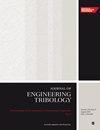Ti-6Al-4V钛合金钻井作业中刀具磨损最小化
IF 1.8
3区 工程技术
Q3 ENGINEERING, MECHANICAL
Proceedings of the Institution of Mechanical Engineers, Part J: Journal of Engineering Tribology
Pub Date : 2023-02-19
DOI:10.1177/13506501231158259
引用次数: 8
摘要
在钻孔作业中,刀具磨损会对刀具、机床和工件造成损坏,对此应进行分析并尽量减少。刀具磨损不仅影响刀具寿命,而且影响最终产品的尺寸精度和表面完整性。Ti-6Al-4V合金等难切削材料在钻进作业中会产生很高的机械和热负荷,在切屑形成过程中会降低刀具的寿命。因此,为了提高Ti6-Al-4V钛合金零件的钻孔精度,应准确预测钻孔过程中刀具的磨损,使其最小化。为了预测Ti-6Al-4V钛合金在钻孔过程中刀具的磨损并使其最小化,研究了虚拟加工系统的应用。为了预测钻井过程中刀具的磨损,计算了切削力和温度。然后,采用Takeyama-Murata分析模型,更新刀具几何形状,利用有限元方法预测刀具在切屑形成过程中的磨损;为了最大限度地减少钻孔过程中刀具的磨损,采用基于田口法的响应面分析算法,得到了进给速度和主轴转速的最佳钻孔参数。因此,为了最大限度地减少钻井过程中切削刀具的磨损,使用了优化的钻井参数。为了验证研究结果,对钛合金Ti6-Al4-V试样进行了实验研究,并测量了刀具磨损值。为了证明所提出的虚拟加工系统在最小化刀具磨损方面的有效性,对优化和不优化加工参数的结果进行了评价和比较。因此,利用所开发的虚拟加工系统可以提高钛合金Ti6-Al4-V的钻孔加工精度和生产率。本文章由计算机程序翻译,如有差异,请以英文原文为准。
Cutting tool wear minimization in drilling operations of titanium alloy Ti-6Al-4V
Cutting tool wear during drilling operations can cause damage to cutting tools, machine tools, and workpieces which should be analyzed and minimized. Cutting tool wear impacts not just tool life but also the quality of the final product in terms of dimensional accuracy and surface integrity. High mechanical and thermal loads are generated during drilling operations of difficult-to-cut materials such as Ti-6Al-4V alloy which can reduce the life of cutting tool during chip formation process. Thus, to increase the accuracy of drilled parts from titanium alloy Ti6-Al-4V, the cutting tool wear during drilling operations should be accurately predicted in order to be minimized. Application of virtual machining systems is developed in the study in order to predict and minimize the cutting tool wear during drilling operations of titanium alloy Ti-6Al-4V. To predict the tool wear during drilling operations, cutting forces and temperature are calculated. Then, the finite element method (FEM) is utilized to predict the tool wear using the analytical model of Takeyama–Murata and updating the cutting tool geometry during chip formation process. To minimize the cutting tool wear during drilling operations, the optimum drilling parameters of feed rate and spindle speed are obtained using the Taguchi method-based response surface analysis algorithm. As a result, optimized drilling parameters are used in order to minimize the cutting tool wear during drilling operations. To validate the study, the experimental works are implemented to the sample workpiece from titanium alloy Ti6-Al4-V and the values of tool wear are then measured. To present the effectiveness of the proposed virtual machining system in minimization of cutting tool wear, the obtained results with and without optimized machining parameters are evaluated and compared. So, precision and productivity in drilling operations of titanium alloy Ti6-Al4-V can be enhanced using the developed virtual machining system in the study.
求助全文
通过发布文献求助,成功后即可免费获取论文全文。
去求助
来源期刊

CiteScore
4.20
自引率
5.00%
发文量
110
审稿时长
6.1 months
期刊介绍:
The Journal of Engineering Tribology publishes high-quality, peer-reviewed papers from academia and industry worldwide on the engineering science associated with tribology and its applications.
"I am proud to say that I have been part of the tribology research community for almost 20 years. That community has always seemed to me to be highly active, progressive, and closely knit. The conferences are well attended and are characterised by a warmth and friendliness that transcends national boundaries. I see Part J as being an important part of that community, giving us an outlet to publish and promote our scholarly activities. I very much look forward to my term of office as editor of your Journal. I hope you will continue to submit papers, help out with reviewing, and most importantly to read and talk about the work you will find there." Professor Rob Dwyer-Joyce, Sheffield University, UK
This journal is a member of the Committee on Publication Ethics (COPE).
 求助内容:
求助内容: 应助结果提醒方式:
应助结果提醒方式:


